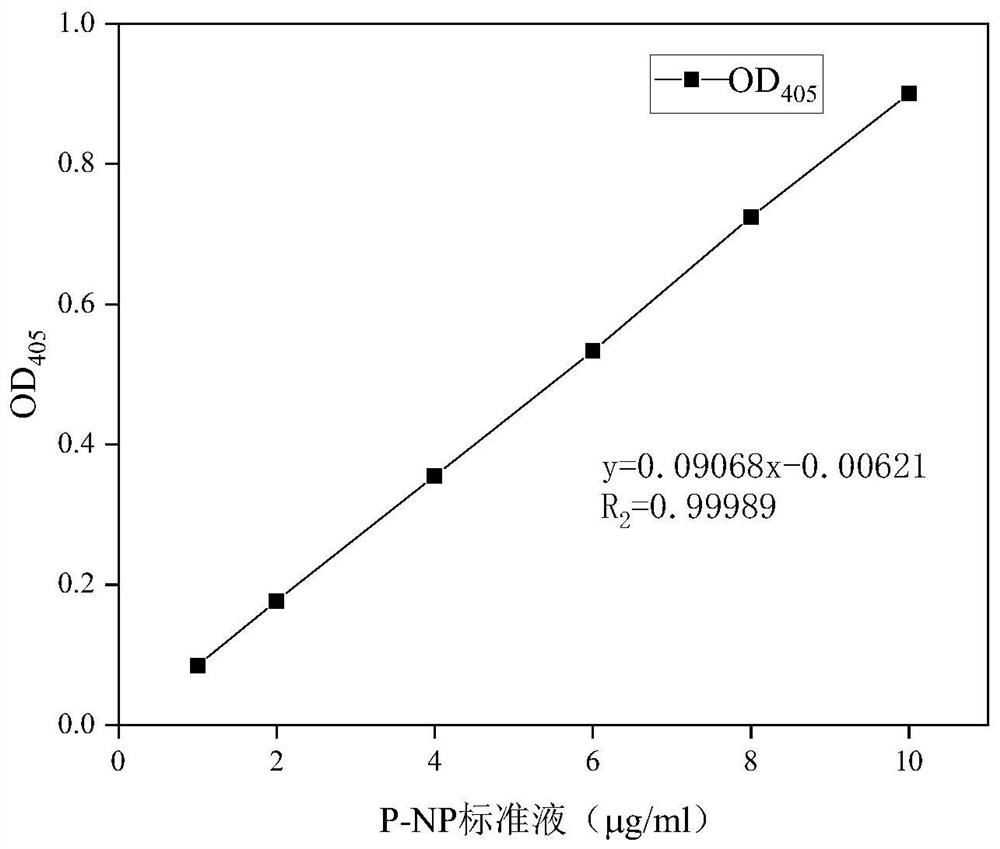High-temperature-resistant kitchen waste grease degradation compound microbial agent and application thereof
A food waste, high temperature resistant technology, applied in the direction of bacteria, solid waste removal, microbial-based methods, etc., can solve problems such as limited research, achieve good application prospects and remarkable treatment effects
- Summary
- Abstract
- Description
- Claims
- Application Information
AI Technical Summary
Problems solved by technology
Method used
Image
Examples
Embodiment 1
[0039]Screening, purification and preservation of strains
[0040] 1. Sampling enrichment
[0041] Sampling was taken from the swill bucket of the canteen of Zhejiang University of Technology, and the swill and kitchen waste were mixed and placed in the sun for 5 days, and 2 mL of the liquid was drawn and inoculated into a 500 mL triangular shaker flask containing 100 mL of enriched medium. Cultured on the bed for 24h.
[0042] 2. Domestication
[0043] Filter the enriched sample with a triangular gauze layer, inoculate 10 mL of bacterial liquid into 100 mL of acclimatization medium containing 5 g / L waste cooking oil, and culture on a shaker at 35°C and 150 rpm for 6 days; take 10 mL of acclimated culture liquid and inoculate it into 100mL acclimatization medium of 10g / L waste cooking oil was cultivated on a shaker at 40°C and 150rpm for 6 days; 6 days was regarded as a cycle. Add 5g / L waste cooking oil progressively, and the temperature rises by 5°C until acclimatization i...
Embodiment 2
[0064] Identification of screened strains
[0065] 1. Colony morphology observation
[0066] Use an inoculation loop to pick a small amount of the strains preserved on the slant of Example 1, streak on the LB plate, culture at 37°C for 1-2 days, and observe the colony morphology.
[0067] 2. Physiological and biochemical tests
[0068] Using the Biolog (GENⅢ) automatic microbial identification system, 94 kinds of phenotypic tests were carried out on the strains, including 71 kinds of carbon source utilization detection and 23 kinds of chemical sensitivity detection: the strains were inoculated on BUG plate medium (BIOLOGUNIVERSAL GROWTH AGAR), 37 Cultivate at constant temperature for 2 days, wash the bacteria on the plate with a sterile cotton swab, mix with the inoculum (IF-A) to make a bacterial suspension, and adjust to 91% T / IF-A with a turbidimeter. Use an 8-hole electric pipette to add the bacterial suspension to each well of the Biolog GENⅢ microwell identification pl...
Embodiment 3
[0078] Compounding of High Temperature Resistance Oil Degrading Bacteria
[0079] 1. Culture medium preparation
[0080]Pick one ring of the five strains preserved on the slant and put them into test tubes containing 5mL LB liquid medium, culture at 37°C and 150rpm for 15-20h to obtain seed liquid; transfer 1mL of seed liquid to 100mL LB liquid medium Put the culture medium in a 500mL Erlenmeyer shaker flask (transfer several flasks for later use), culture at 37°C and 150rpm for 15-20h, and obtain a culture solution.
[0081] 2. The degradation ability of different strains
[0082] The strain 31a is marked 1, the strain L22 is marked 2, the strain AJ1 is marked 3, the strain B23 is marked 4, and the strain B7 is marked 5. A total of ten combinations 123, 145, 245, 125, 134, 1234, 1235, 1245, 1345, 2345 were selected, according to 2% (in OD 600 The absorbance is 1.0, and the volume ratio of the diluted bacterial solution is 1) The inoculum amount of each combined bacterial s...
PUM
| Property | Measurement | Unit |
|---|---|---|
| boiling point | aaaaa | aaaaa |
Abstract
Description
Claims
Application Information
 Login to View More
Login to View More - Generate Ideas
- Intellectual Property
- Life Sciences
- Materials
- Tech Scout
- Unparalleled Data Quality
- Higher Quality Content
- 60% Fewer Hallucinations
Browse by: Latest US Patents, China's latest patents, Technical Efficacy Thesaurus, Application Domain, Technology Topic, Popular Technical Reports.
© 2025 PatSnap. All rights reserved.Legal|Privacy policy|Modern Slavery Act Transparency Statement|Sitemap|About US| Contact US: help@patsnap.com



